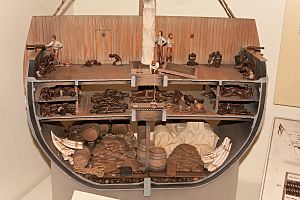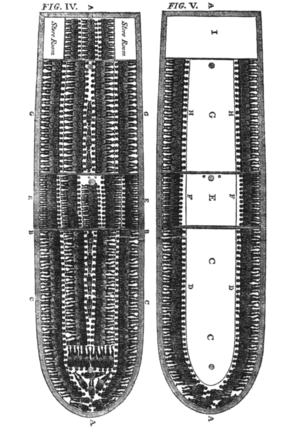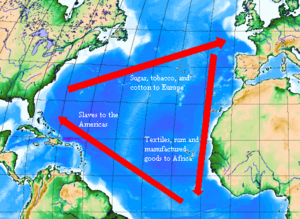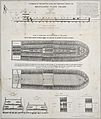Middle Passage facts for kids
The Middle Passage was a terrible journey across the Atlantic Ocean. It was the part of the Atlantic slave trade where African people were kidnapped and forced onto slave ships. These ships then carried them to the Americas. Millions of African people were taken from their homes and shipped across the ocean during the Middle Passage.

The enslaved people were treated very badly on these ships. About 15% of them died during the journey itself. Even more people were killed before they even left Africa, as slave traders kidnapped them and forced them onto the ships. Historians believe that up to two million African people died during the Middle Passage. However, between 9.4 million and 12 million Africans survived this journey and arrived in the Americas as enslaved people.
Contents
What was the Triangular Trade?
The Atlantic slave trade had three main parts. Because of this, it was called "the triangular trade." The Middle Passage got its name because it was the middle part of this trade triangle. The three parts of the Atlantic slave trade were:
- Part 1: Europe to Africa
Ships sailed from Europe to Africa. They carried things like weapons, gunpowder, cloth, and rum. In Africa, these goods were traded for African people who had been bought or kidnapped to be enslaved.
- Part 2: Africa to the Americas (The Middle Passage)
African enslaved people were forced onto slave ships and brought to the Americas. There, they were sold as slaves. Sometimes, they were traded for raw materials like sugar, tobacco, and cotton. These materials were often grown or made by other enslaved people.
- Part 3: The Americas to Europe
The raw materials from the Americas were sent to Europe. There, they were used to make other goods. Then, the triangular trade would start all over again. For example, cotton from the Americas would be used to make cloth in Europe. This cloth could then be sent to Africa to trade for more enslaved people.
The Journey of Enslaved People

After being kidnapped, African people were usually forced to walk long distances to forts along the coast of western Africa. There, they were sold to European and American slave traders. They might have to wait in these forts, which were like prisons, for many months before slave ships arrived.
Once a ship arrived, the enslaved people were packed onto it. They were often squeezed together as tightly as possible. Sometimes, they were allowed to move a little during the day. However, many ships kept the people chained up for the entire trip.
Sailing through the Middle Passage could take a long time, from one to six months. The exact time depended on the weather. Over the years, slave ships became faster. In the early 16th century, a trip often took a few months. But by the 19th century, many slave ships crossed the Middle Passage in less than six weeks.
Life on the Ships
The enslaved people were treated terribly during the Middle Passage. They were not seen as human beings. Instead, they were thought of as "cargo" or "goods"—just things to be bought and sold.
They were given very little food. The best slave ships fed the enslaved people beans, corn, yams, rice, and palm oil. But they were not always fed every day. If there wasn't enough food for everyone, the sailors would eat first. The enslaved people might not get any food at all. On some ships, sick people were not given food. Many people died from starvation and dehydration (not having enough water) during the journey.
The living conditions on the slave ships were awful. Diseases spread very quickly because the enslaved people were so crowded together. There was also no proper sanitation, meaning waste and dirt were everywhere.
Enslaved people were often punished if they did not follow the sailors' orders. They were also punished if they seemed disobedient. For example, anyone who was too sad or sick to eat might be beaten or whipped.
Who Took Part?
Many different people and countries were involved in the Middle Passage and the triangular trade.
European Countries
The countries that controlled most of the slave trade were powerful European nations. These included:
- Portugal
- England
- Spain
- France
- The Netherlands
- Denmark
- Sweden
- Brandenburg (which is now part of Germany)
Slave traders in North America, Brazil, and the Caribbean also took part in the slave trade.
Different countries were more powerful in the slave trade at different times. For example, for 200 years (from 1440 to 1640), Portugal almost completely controlled the slave trade. But over time, the power in Europe changed. By the 18th century, the British Empire was much stronger. During the 18th century, when 6 million Africans were brought over the Middle Passage, British slave traders carried almost 2.5 million of them.
African People
Most of the African enslaved people came from eight different areas:
- Senegambia (now Senegal and Gambia)
- Upper Guinea
- Windward Coast (now the Ivory Coast)
- Gold Coast (now Ghana)
- Bight of Benin
- Bight of Biafra, off the western coast of Africa
- West Central Africa
- Southeastern Africa
Slave Traders
The slave trade was very profitable for slave traders. By the late 18th century, a strong male slave could be sold for about $600 to $1500. This would be like $9,000 to $15,000 in United States dollars today. Because of this, kidnapping people in Africa and selling them into slavery became more and more common. Historians believe that African warlords, kings, and private kidnappers—Europeans, Americans, and Africans alike—all took part in kidnapping people for slavery.
Photo Gallery
Related Pages
Images for kids
See also
 In Spanish: Pasaje del medio para niños
In Spanish: Pasaje del medio para niños







